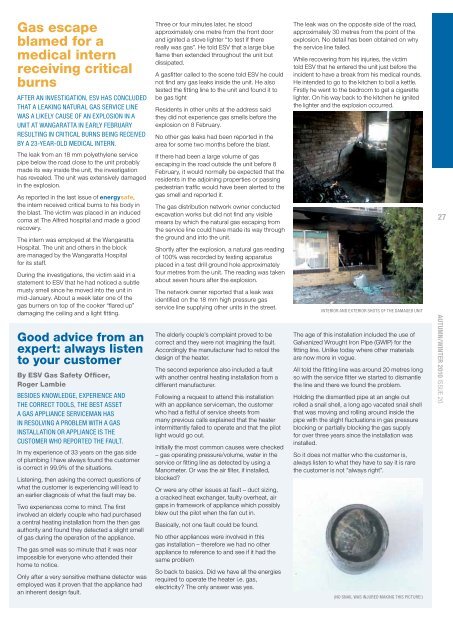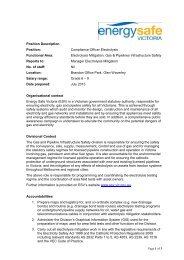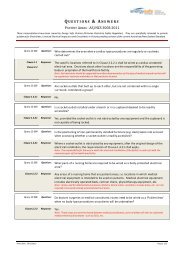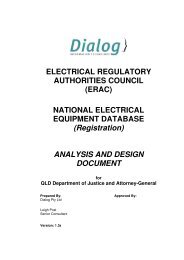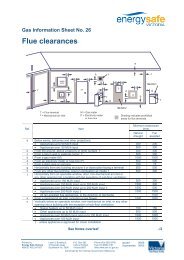AUTUmN/WiNTER 2010 ISSUE 20 (PDF) - Energy Safe Victoria
AUTUmN/WiNTER 2010 ISSUE 20 (PDF) - Energy Safe Victoria
AUTUmN/WiNTER 2010 ISSUE 20 (PDF) - Energy Safe Victoria
Create successful ePaper yourself
Turn your PDF publications into a flip-book with our unique Google optimized e-Paper software.
Gas escapeblamed for amedical internreceiving criticalburnsAfter an investigation, ESV has concludedthat a leaking natural gas service linewas a likely cause of an explosion in aunit at Wangaratta in early Februaryresulting in critical burns being receivedby a 23-year-old medical intern.The leak from an 18 mm polyethylene servicepipe below the road close to the unit probablymade its way inside the unit, the investigationhas revealed. The unit was extensively damagedin the explosion.Three or four minutes later, he stoodapproximately one metre from the front doorand ignited a stove lighter “to test if therereally was gas”. He told ESV that a large blueflame then extended throughout the unit butdissipated.A gasfitter called to the scene told ESV he couldnot find any gas leaks inside the unit. He alsotested the fitting line to the unit and found it tobe gas tightResidents in other units at the address saidthey did not experience gas smells before theexplosion on 8 February.No other gas leaks had been reported in thearea for some two months before the blast.The leak was on the opposite side of the road,approximately 30 metres from the point of theexplosion. No detail has been obtained on whythe service line failed.While recovering from his injuries, the victimtold ESV that he entered the unit just before theincident to have a break from his medical rounds.He intended to go to the kitchen to boil a kettle.Firstly he went to the bedroom to get a cigarettelighter. On his way back to the kitchen he ignitedthe lighter and the explosion occurred.As reported in the last issue of energysafe,the intern received critical burns to his body inthe blast. The victim was placed in an inducedcoma at The Alfred hospital and made a goodrecovery.The intern was employed at the WangarattaHospital. The unit and others in the blockare managed by the Wangaratta Hospitalfor its staff.During the investigations, the victim said in astatement to ESV that he had noticed a subtlemusty smell since he moved into the unit inmid-January. About a week later one of thegas burners on top of the cooker “flared up”damaging the ceiling and a light fitting.Good advice from anexpert: always listento your customerBy ESV Gas <strong>Safe</strong>ty Officer,Roger LambieBesides knowledge, experience andthe correct tools, the best asseta gas appliance serviceman hasin resolving a problem with a gasinstallation or appliance is thecustomer who reported the fault.In my experience of 33 years on the gas sideof plumbing I have always found the customeris correct in 99.9% of the situations.Listening, then asking the correct questions ofwhat the customer is experiencing will lead toan earlier diagnosis of what the fault may be.Two experiences come to mind. The firstinvolved an elderly couple who had purchaseda central heating installation from the then gasauthority and found they detected a slight smellof gas during the operation of the appliance.The gas smell was so minute that it was nearimpossible for everyone who attended theirhome to notice.Only after a very sensitive methane detector wasemployed was it proven that the appliance hadan inherent design fault.If there had been a large volume of gasescaping in the road outside the unit before 8February, it would normally be expected that theresidents in the adjoining properties or passingpedestrian traffic would have been alerted to thegas smell and reported it.The gas distribution network owner conductedexcavation works but did not find any visiblemeans by which the natural gas escaping fromthe service line could have made its way throughthe ground and into the unit.Shortly after the explosion, a natural gas readingof 100% was recorded by testing apparatusplaced in a test drill ground hole approximatelyfour metres from the unit. The reading was takenabout seven hours after the explosion.The network owner reported that a leak wasidentified on the 18 mm high pressure gasservice line supplying other units in the street.The elderly couple’s complaint proved to becorrect and they were not imagining the fault.Accordingly the manufacturer had to retool thedesign of the heater.The second experience also included a faultwith another central heating installation from adifferent manufacturer.Following a request to attend this installationwith an appliance serviceman, the customerwho had a fistful of service sheets frommany previous calls explained that the heaterintermittently failed to operate and that the pilotlight would go out.Initially the most common causes were checked– gas operating pressure/volume, water in theservice or fitting line as detected by using aManometer. Or was the air filter, if installed,blocked?Or were any other issues at fault – duct sizing,a cracked heat exchanger, faulty overheat, airgaps in framework of appliance which possiblyblew out the pilot when the fan cut in.Basically, not one fault could be found.No other appliances were involved in thisgas installation – therefore we had no otherappliance to reference to and see if it had thesame problemSo back to basics. Did we have all the energiesrequired to operate the heater i.e. gas,electricity? The only answer was yes.Interior and exterior shots of the damaged unitThe age of this installation included the use ofGalvanized Wrought Iron Pipe (GWIP) for thefitting line. Unlike today where other materialsare now more in vogue.All told the fitting line was around <strong>20</strong> metres longso with the service fitter we started to dismantlethe line and there we found the problem.Holding the dismantled pipe at an angle outrolled a snail shell, a long ago vacated snail shellthat was moving and rolling around inside thepipe with the slight fluctuations in gas pressureblocking or partially blocking the gas supplyfor over three years since the installation wasinstalled.So it does not matter who the customer is,always listen to what they have to say it is rarethe customer is not “always right”.(No Snail was injured making this picture!)27Autumn/Winter <strong><strong>20</strong>10</strong> <strong>ISSUE</strong> <strong>20</strong>


